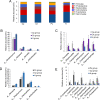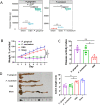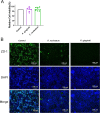Key periodontal pathogens may mediate potential pathogenic relationships between periodontitis and crohn's disease
- PMID: 38849764
- PMCID: PMC11161938
- DOI: 10.1186/s12903-024-04425-0
Key periodontal pathogens may mediate potential pathogenic relationships between periodontitis and crohn's disease
Abstract
Background: Crohn's disease (CD)-associated periodontitis is common. However, the role of periodontal pathogens in the Coexistence of CD and periodontal disease remains unclear.
Methods: To investigate the potential relationship mediated by periodontal pathogens between periodontitis and CD, we collected salivary samples from healthy participants (H group, n = 12), patients with CD (Ch group, n = 10), patients with periodontitis (Ps group, n = 12), and patients with Coexistence of CD and periodontal disease (Cp group, n = 12) and analyzed them by 16 S rRNA sequencing.
Results: Patients with Coexistence of CD and periodontal disease had increased levels of Fusobacterium, Actinomyces, Leptotrichia, and Prevotella, which correlated with the severity of periodontitis. Conversely, the levels of Streptococcus, Neisseria, Haemophilus, and Gemella, which decreased in Coexistence of CD and periodontal disease, were negatively correlated with the severity of periodontitis. To further investigate the role of periodontal pathogens in CD development, representative periodontal pathogens causing periodontitis, Porphyromonas gingivalis and Fusobacterium nucleatum, were administered to mice. These pathogens migrate to, and colonize, the gut, accelerating CD progression and aggravating colitis, and even systemic inflammation. In vitro experiments using a Caco-2/periodontal pathogen coculture revealed that P. gingivalis and F. nucleatum increased intestinal permeability by directly disrupting the tight junctions of intestinal epithelial cells.
Conclusion: Our findings strongly suggest that periodontal pathogens play a role in the relationship between periodontitis and CD. These results provide a basis for understanding the pathogenesis of Coexistence of CD and periodontal disease and may lead to the development of novel therapeutic strategies.
Keywords: Fusobacterium nucleatum; Porphyromonas gingivalis; Crohn’s disease; Periodontal pathogens; Periodontitis.
© 2024. The Author(s).
Conflict of interest statement
The authors declare no competing interests.
Figures






Similar articles
-
The oral microbiome analysis reveals the similarities and differences between periodontitis and Crohn's disease-associated periodontitis.FEMS Microbiol Lett. 2022 Jul 28;369(1):fnac054. doi: 10.1093/femsle/fnac054. FEMS Microbiol Lett. 2022. PMID: 35689660
-
Fusobacterium nucleatum Metabolically Integrates Commensals and Pathogens in Oral Biofilms.mSystems. 2022 Aug 30;7(4):e0017022. doi: 10.1128/msystems.00170-22. Epub 2022 Jul 19. mSystems. 2022. PMID: 35852319 Free PMC article.
-
Progression of periodontal inflammation in adolescents is associated with increased number of Porphyromonas gingivalis, Prevotella intermedia, Tannerella forsythensis, and Fusobacterium nucleatum.Int J Paediatr Dent. 2014 May;24(3):226-33. doi: 10.1111/ipd.12065. Epub 2013 Sep 12. Int J Paediatr Dent. 2014. PMID: 24025042
-
[Research progress of correlation between periodontal pathogens and systemic diseases].Nan Fang Yi Ke Da Xue Xue Bao. 2020 May 30;40(5):759-764. doi: 10.12122/j.issn.1673-4254.2020.05.24. Nan Fang Yi Ke Da Xue Xue Bao. 2020. PMID: 32897213 Free PMC article. Review. Chinese.
-
Immunological Pathways Triggered by Porphyromonas gingivalis and Fusobacterium nucleatum: Therapeutic Possibilities?Mediators Inflamm. 2019 Jun 24;2019:7241312. doi: 10.1155/2019/7241312. eCollection 2019. Mediators Inflamm. 2019. PMID: 31341421 Free PMC article. Review.
Cited by
-
Shattering the Amyloid Illusion: The Microbial Enigma of Alzheimer's Disease Pathogenesis-From Gut Microbiota and Viruses to Brain Biofilms.Microorganisms. 2025 Jan 5;13(1):90. doi: 10.3390/microorganisms13010090. Microorganisms. 2025. PMID: 39858858 Free PMC article. Review.
-
In vitro modulation of proinflammatory and proteolytic activities of Porphyromonas gingivalis by selected lactobacilli.J Oral Microbiol. 2025 Feb 25;17(1):2469894. doi: 10.1080/20002297.2025.2469894. eCollection 2025. J Oral Microbiol. 2025. PMID: 40013015 Free PMC article.
References
MeSH terms
Substances
Grants and funding
LinkOut - more resources
Full Text Sources
Medical
Miscellaneous

